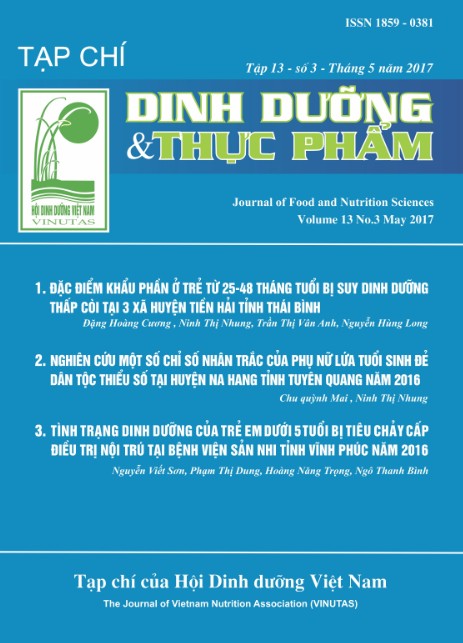STATUS OF ANEMIA, DEFICIENCIES OF IRON AND VITAMIN A IN WOMEN PRIOR TO THE FIRST PREGNANCY IN CAM KHE DISTRICT, PHU THO PROVICE
Main Article Content
Abstract
Objectives: To determine the status of anemia, deficiencies of iron and vitamin A in women prior to the first pregnancy in Cam Khe District, Phu Tho Province (CK-PT). Subjects and methods: A cross sectional study was conducted on 411 women from 18 to 30 years old, who have never been pregnant, living in CK-PT. The evaluation of the status of iron deficiency was based on the following biochemical indexes: Transferrin receptor, Ferritin; body iron; some indicators to exclude infection were C-Reactive Protein (CRP) and Alpha 1-Acid Glycoprotein (AGP). Hb indicator was used to evaluate the anemia status. The evaluation of the vitamin A status was based on the following indexes: serum VitA and Retinol binding protein. Results: The prevalence of depleted iron stores in the anemic group was 10.1% that was higher than that of the non-anemic group (3.2%) with p<0.01. In iron-deficient group, the mean RBP concentration was 1.06 ± 0.39 μmol/L which was lower than that in normal-iron status group (1.15 ± 0.41 μmol/L) and mean CRP concentration was 0.3 (0.1; 0.9) mg/L which was higher than that of the group of normal-iron status (p<0.01). Conclusion: The prevalence of anemia in the women prior to the first pregnancy in Cam Khe Phu Tho was 20.7% that was an average level of public health significance, among the anemic subjects, 43.0% non-infectious subjects that were iron deficient; the prevalence of iron deficiency was 37.9%; the prevalence of vitamin A-deficiency was 10.2%.
Keywords
Anemia, iron deficiency, vitamin A deficiency, women from 18 to 30 years old, women prior to the first pregnancy, Phu Tho
Article Details
References
2. Ramakrishnan U (2004). "Nutrition and low birth weight: from research to practice", Am J Clin Nutr, 79: p. 17-21
3. West K P (2002). "Extent of vitamin A deficiency among preschool children and women of reproductive age", J Nutr. 132: p. 2857S-66S
4. Viện Dinh dưỡng Quốc Gia (2015). "Số liệu điều tra về vi chất dinh dưỡng năm
2014-2015. Số liệu thống kê về vi chất dinh dưỡng 2015", trang mạng của Viện Dinh dưỡng Quốc Gia: http//vichat.viendinhduong.vn
5. Bộ Y tế and Viện Dinh Dưỡng (2010).
"Tổng điều tra dinh dương 2009-2010".Nhà xuất bản Y học.
6. Rosalind S. Gibson (2005). "Assessment of the status of vitamin A, D, and E. Principles nutritional assessment" - The second edition. Oxford University Press. 477- 527.
7. Mei Z, et al. (2011). "Assessment of iron status in US pregnant women from the National Health and Nutrition Examination Survey (NHANES), 1999–2006". Am J Clin Nutr. 93: p. 1312–1320.
8. Cook J D, Flowers C H, and Skikne B S (2003). "The quantitative asessment of body iron". Blood. 101(9): p. 3359-3364.
9. Halimatou A, et al. (2017). "Prevalence of anaemia, deficiencies of iron and vitamin A and their determinants in rural women and young children: a cross-sectional study in Kalalé district of northern Benin". Public Health Nutrition. 20(7): p. 1203-1213.
10.Sabuktagin R, et al. (2016). "Vitamin A deficiency and determinants of vitamin A status in Bangladeshi children and women: findings of a national survey". Public Health Nutrition. 20(6): p. 1114- 1125.
Similar Articles
- Trong Hung NGUYEN, Le Hoang Duy, Thi Nhung NINH, Thi Dzung PHAM, Ngoc Khai PHAM, SOYBEANS, SOY-BASED PRODUCTS AND HEART HEALTH , Vietnam Journal of Nutrition & Food: Vol. 18 No. 3+4 (2022)
You may also start an advanced similarity search for this article.


